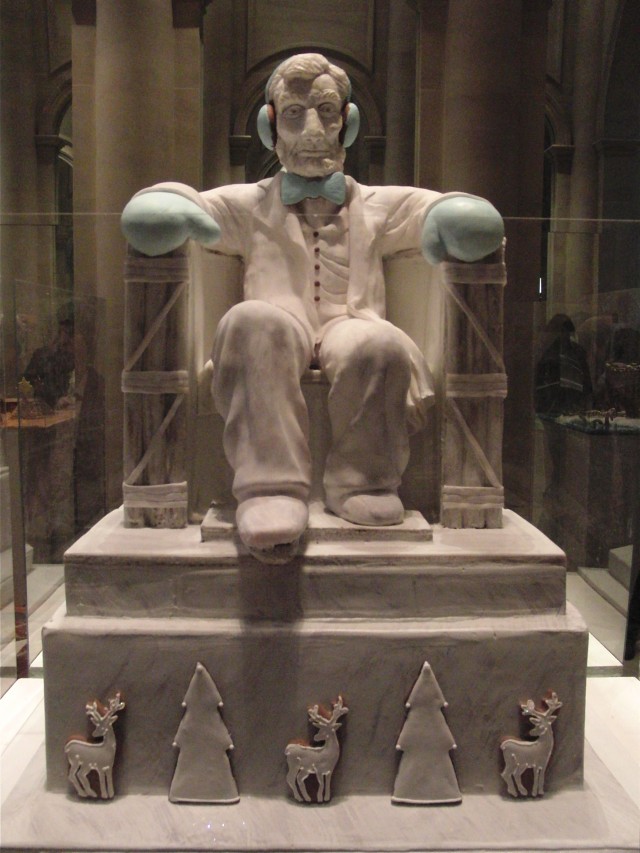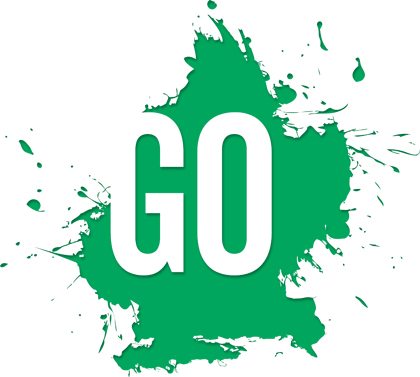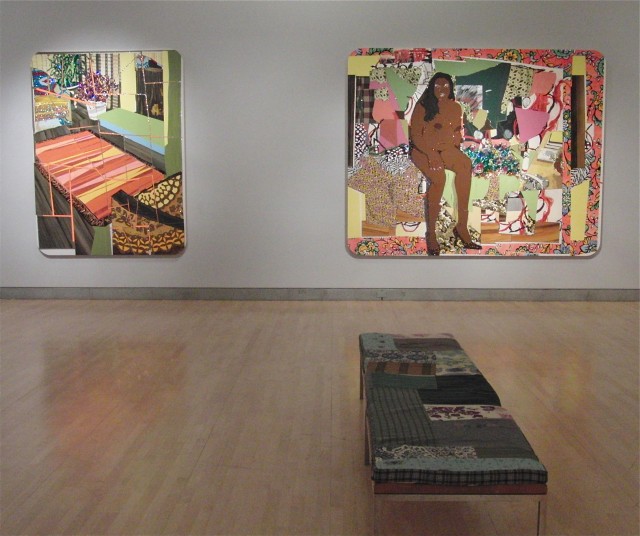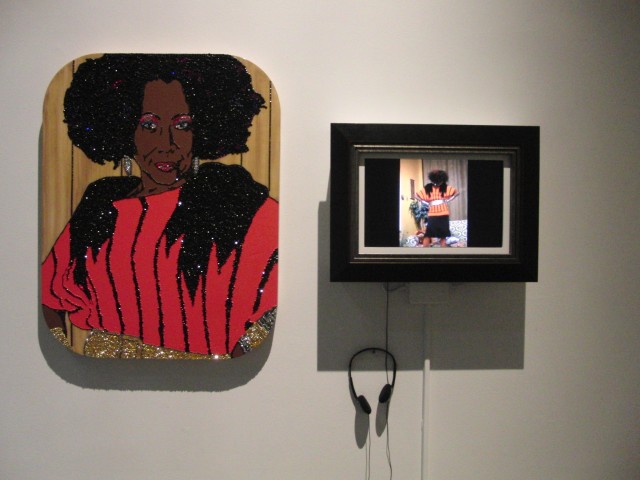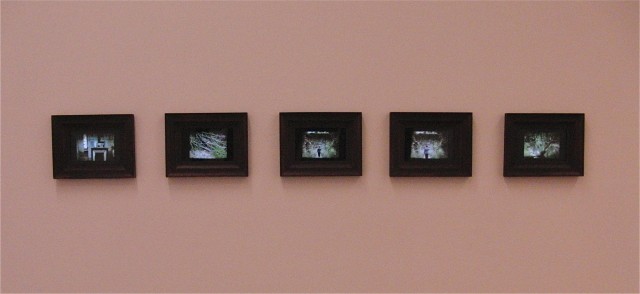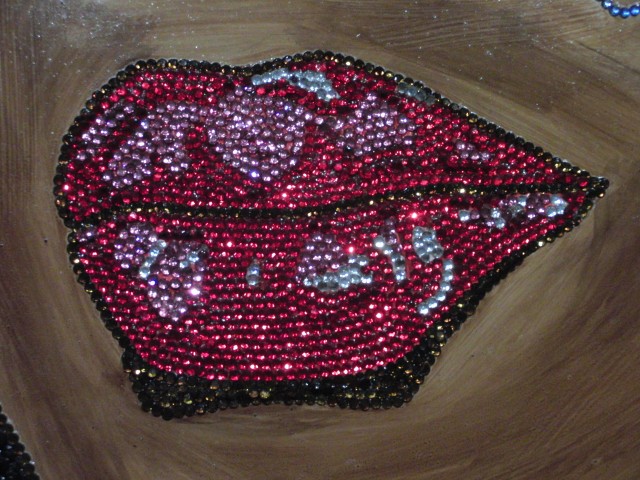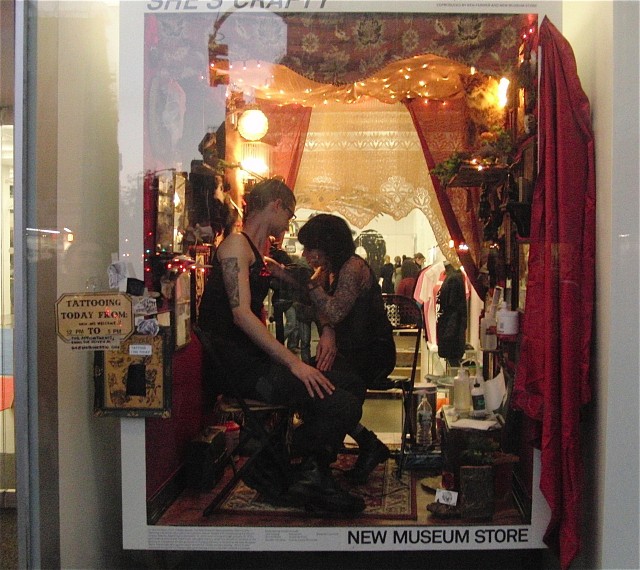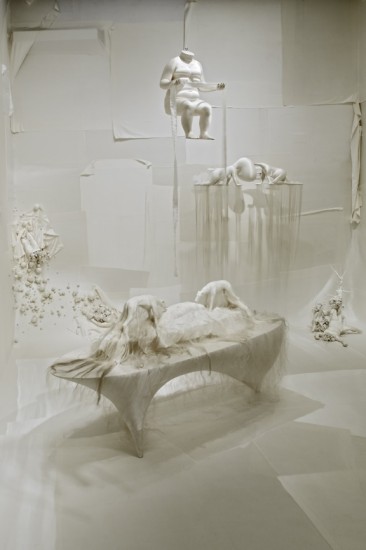
Lin Tianmiao, “Mother’s!!!,” polyurea, silk, cotton threads, 2008 (photo © Michael Bodycomb)
CHINA CLOSE UP: BOUND UNBOUND
Asia Society
725 Park Ave. at 70th St.
Tuesday – Sunday through January 27, $10 (free Friday 6:00 – 9:00)
212-288-6400
www.asiasociety.org
BADGES
Galerie Lelong
528 West 26th St. between Tenth & Eleventh Aves.
Tuesday – Saturday through December 15
212-315-0470
www.galerielelong.com
One of the foremost Chinese artists, Lin Tianmiao has been exploring the nature of gender through challenging sculpture, photographs, video, and installation for nearly twenty years, focusing particularly on incorporating what is considered “women’s work” and the role of the mother in her thought-provoking pieces, as seen in two current exhibits in Manhattan. At Asia Society (through January 27), “Bound Unbound: Lin Tianmiao” fills two floors and three galleries with several of Lin’s most intriguing installations. The earliest is her 1995 work “Proliferation of Thread Winding,” an eerie bed with twenty thousand steel needles tied to raw cotton thread that develops into small balls on the floor; a video monitor depicting the act of creating the balls serves as a pillow. It’s a terrific introduction to Lin’s multidisciplinary oeuvre: At first it looks like an extravagant marriage bed, then ends up being a statement on female domestic labor (melding both work and childbirth). Similarly, 1997’s “Bound and Unbound” features dozens of household items wrapped in thread while a film projection shows thread being cut. In “Chatting,” a group of six naked women, all based on Lin’s own body, stand on a pink platform, their box-shaped heads cast downward sadly, connected by thin wires that vibrate as a soundtrack of them talking can barely be heard. Nearby is “Endless,” a trio of three shriveled old men in pink who look so fragile that a mere breath could knock them over.
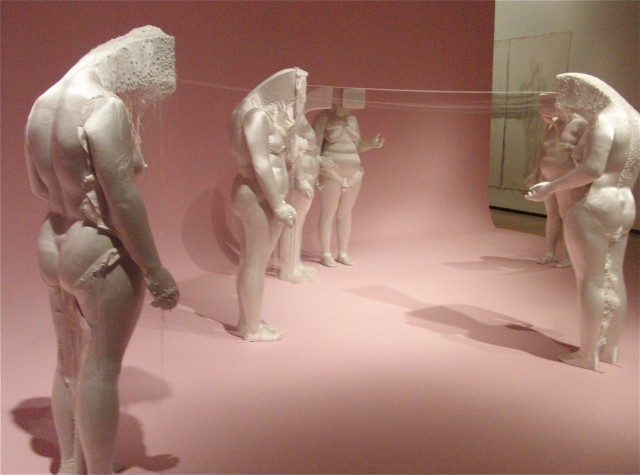
Lin Tianmiao, “Chatting” (photo by twi-ny/mdr)
Although Lin, who spent eight years in New York City with her artist husband, Wang GongXin, before returning to Beijing in 1995, prefers not to be considered a feminist artist, the history and power of gender is central to her work. In “Sewing,” she has wrapped a sewing machine in white cotton thread and projects onto it a video of the act of sewing. In its own walk-in white room, “Mother’s!!!” consists of multiple headless female figures, both children and adults. In 2009, Lin made a major shift following the death of her mother, wrapping synthetic skulls and bones and placing them on exuberantly colored canvases and combining them with tools, giving them such titles as “All the Same” and “More or Less the Same,” inherently invoking that there is no difference between men, women, and children under the skin and noting that death awaits us all. Yet the works are not depressing nor morbid. “I believe that the bone is the only perfect object left in the world,” Lin says in the exhibition catalog. On December 7, Asia Society will host a free holiday celebration from 6:00 to 9:00 with guided tours of “Bound Unbound,” live jazz from pianist A. J. Khaw, trumpeter Jean Caze, and bassist Jon Price, a tea tasting and demonstration, store discounts, and more.
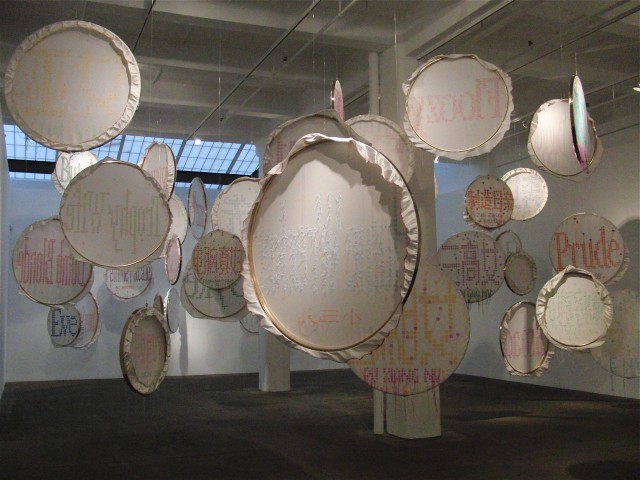
Lin Tianmiao, “Badges,” white silk, colored silk thread, painted stainless steel embroidery frame, sound component, 2011-12 (photo by twi-ny/mdr)
At Galerie Lelong through December 15, “Badges” features sixty white circles dangling from the ceiling, each bearing an embroidered slang word referring to women. Meanwhile, a robotic voice pronounces each one in an endless stream as the works twist around, making the text hard to read. Ranging in size from a diameter of 31.5 to 47.2 inches and in both English and Chinese, they display such stereotyped terms as “Dyke,” “Floozy,” “Tramp,” “Ho,” “Soccer Mom,” “Trophy Wife,” “Slut,” “Dumb Blonde,” “Home Wrecker,” and “Bimbo.” (Some of the Chinese phrases translate as “a woman who sleeps around,” “a woman who is unattractive both physically and in terms of personality,” “a well-educated woman with a high income and other highly sought after qualities but who has been unable to find a husband,” and “a woman who spends one third of her salary on her phone bill because she enjoys talking on the phone so much.”) Process, form, function, and gender all come together in a compelling display that deserves extended time to marvel in its complex simplicity. The exhibit also includes several of Lin’s more recent “Same” canvases, made of striking green, pink, and yellow with frames featuring wrapped bones. Seen together, “Bound Unbound” and “Badges” establish Lin as a major contemporary artist with fascinating ideas on the role of women in modern society.
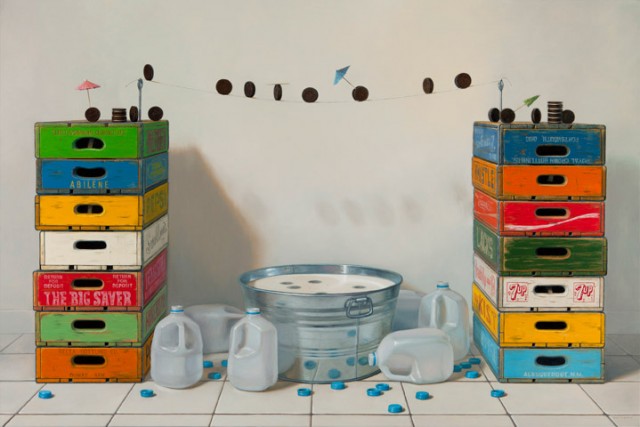
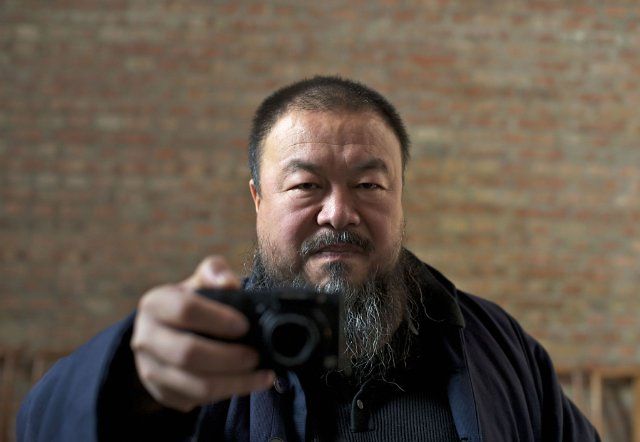
 “I consider myself more of a chess player,” Ai Weiwei says at the beginning of Never Sorry, Alison Klayman’s revealing documentary about the larger-than-life Chinese artist and dissident. “My opponent makes a move, I make a move. Now I’m waiting for my opponent to make the next move.” Over the last several years, Ai has become perhaps the most famous and controversial artist in the world, primarily since he participated in the design of Beijing National Stadium, known as the Bird’s Nest, for the 2008 Summer Olympics, then denounced the Games on political grounds. Ai gives director, producer, and cinematographer Klayman, making her first full-length film, remarkable access to his personal and professional life as he gets physically abused by Chinese police, prepares to open major exhibits in Munich and London, and visits with his young son, Ai Lao, the result of a tryst with Wang Fen, an editor on his underground films. Klayman speaks with Ai Weiwei’s devoted wife, Lu Qing, an artist who publicly fought for his freedom when he disappeared in 2011; his mother, Gao Ying, who spent time in a labor camp with her dissident-poet husband, the late Ai Quing; and such fellow Chinese artists and critics as Chen Danqing, Feng Boyi, Hsieh Tehching, and Gu Changwei, who speak admiringly of Ai’s dedication to his art and his fearless search for the truth. A round man with a long, graying bear, Ai is a fascinating, complicated character, a gentle bull who openly criticizes his country because he loves it so much. He is a social media giant, making documentaries that are available for free on the internet and revolutionizing the way Twitter and the blogosphere are used. Ai risks his own freedom by demanding freedom for all, calling for government transparency before and after he is secretly arrested, not afraid of the potential repercussions. And he is also a proud cat lover — more than forty felines regularly roam around his studio — eagerly showing off one talented kitty that has a unique way of opening a door. Ai Weiwei: Never Sorry shows Ai to be an honorable, supremely principled human being who has deep respect for the history of China and a fierce determination to improve its future, no matter the personal cost. Ai Weiwei: Never Sorry is being shown on December 12 at 7:00 as part of MoMA’s annual series “The Contenders,” consisting of exemplary films they believe will stand the test of time, with Klayman on hand to participate in a postscreening discussion; upcoming entries include Steven Spielberg’s Lincoln, Charles Atlas’s Ocean, and Tim Burton’s Frankenweenie. (To find out more about Ai Weiwei’s art, specifically his recent projects in New York City, please follow these links:
“I consider myself more of a chess player,” Ai Weiwei says at the beginning of Never Sorry, Alison Klayman’s revealing documentary about the larger-than-life Chinese artist and dissident. “My opponent makes a move, I make a move. Now I’m waiting for my opponent to make the next move.” Over the last several years, Ai has become perhaps the most famous and controversial artist in the world, primarily since he participated in the design of Beijing National Stadium, known as the Bird’s Nest, for the 2008 Summer Olympics, then denounced the Games on political grounds. Ai gives director, producer, and cinematographer Klayman, making her first full-length film, remarkable access to his personal and professional life as he gets physically abused by Chinese police, prepares to open major exhibits in Munich and London, and visits with his young son, Ai Lao, the result of a tryst with Wang Fen, an editor on his underground films. Klayman speaks with Ai Weiwei’s devoted wife, Lu Qing, an artist who publicly fought for his freedom when he disappeared in 2011; his mother, Gao Ying, who spent time in a labor camp with her dissident-poet husband, the late Ai Quing; and such fellow Chinese artists and critics as Chen Danqing, Feng Boyi, Hsieh Tehching, and Gu Changwei, who speak admiringly of Ai’s dedication to his art and his fearless search for the truth. A round man with a long, graying bear, Ai is a fascinating, complicated character, a gentle bull who openly criticizes his country because he loves it so much. He is a social media giant, making documentaries that are available for free on the internet and revolutionizing the way Twitter and the blogosphere are used. Ai risks his own freedom by demanding freedom for all, calling for government transparency before and after he is secretly arrested, not afraid of the potential repercussions. And he is also a proud cat lover — more than forty felines regularly roam around his studio — eagerly showing off one talented kitty that has a unique way of opening a door. Ai Weiwei: Never Sorry shows Ai to be an honorable, supremely principled human being who has deep respect for the history of China and a fierce determination to improve its future, no matter the personal cost. Ai Weiwei: Never Sorry is being shown on December 12 at 7:00 as part of MoMA’s annual series “The Contenders,” consisting of exemplary films they believe will stand the test of time, with Klayman on hand to participate in a postscreening discussion; upcoming entries include Steven Spielberg’s Lincoln, Charles Atlas’s Ocean, and Tim Burton’s Frankenweenie. (To find out more about Ai Weiwei’s art, specifically his recent projects in New York City, please follow these links: 


